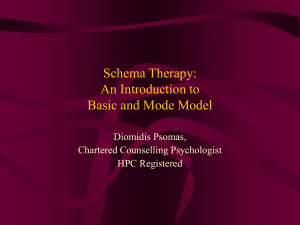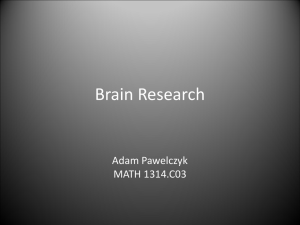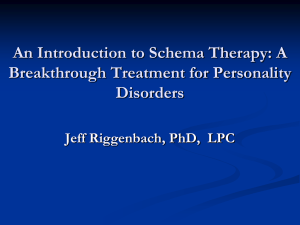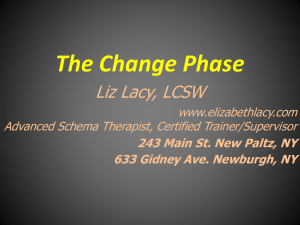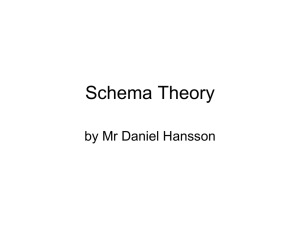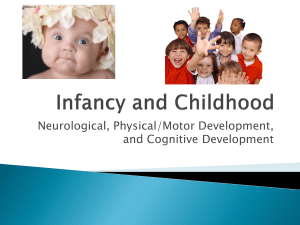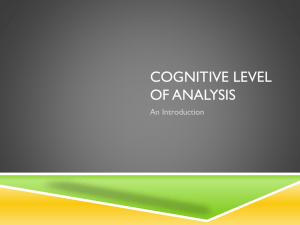Brief Schema Therapy:Conceptual Model
advertisement
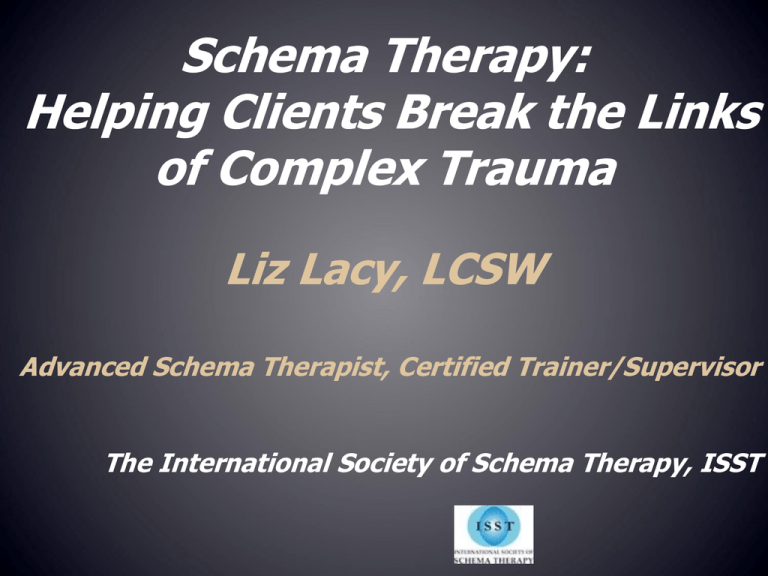
Schema Therapy: Helping Clients Break the Links of Complex Trauma Liz Lacy, LCSW Advanced Schema Therapist, Certified Trainer/Supervisor The International Society of Schema Therapy, ISST Complex Trauma: • Definition: repetitive, prolonged and/or cumulative • Most often interpersonal – direct harm, exploitation and maltreatment (including abandonment, neglect) • Usually occur at developmentally vulnerable time – but can occur later if repetitive, prolonged Common Reactions Affection Dysregulation (anger, selfdestructivene ss, methods of self soothing) Somatization Difficulties in Relationships with others (trust) Changes in attention and consciousness (dissociative, numbing, detachment) Negative SelfPerception (esp shame) Schema Therapy Defined An integrative, trans-diagnostic, unifying theory & treatment Designed to treat a variety of long-standing emotional difficulties, in individuals & couples With significant origins in childhood & adolescent development Combines elements of cognitive-behavioral, emotion-focused, attachment & object relations models ST vs other Evidence-Based Treatments for Trauma • Prolonged Exposure • Cognitive Processing Therapy (with or without narrative) • EMDR – negative cognitions and images • DBT – Best for Stage 1 BPD Treatment • Schema Therapy Outcome Research Arntz, A. (2008). Schema-focused therapy for borderline personality disorder and complex trauma: effectiveness and cost-effectiveness, evidence from a multicenter trial. European Psychiatry, 23, Suppl. 2, S65-S66. Arntz, A., Tiesema, M., & Kindt, M. (2007). Treatment of PTSD: a comparison of imaginal exposure with and without imagery rescripting. Journal of Behaviour Therapy and Experimental Psychiatry, 38, 345-370. Cockram, D. M., Drummond, P. D., & Lee, C. W. (2010). Role and Treatment of Early Maladaptive Schemas in Vietnam Veterans with PTSD. Retrieved May 2, 2012, from www.interscience.wiley.com Morrison, N. (2000). Schema-focused cognitive therapy for complex long-standing problems: a single-case study. Behavioural and Cognitive Psychotherapy ST Core Components • Limited Re-parenting • Empathic Confrontation • Experiential Strategies • Cognitive Strategies • Case Conceptualization Stages of Treatment • Comprehensive Assessment: written, history, imagery, YSI, SMI • Case Conceptualization • Change Stage: Breaking Links, Meeting Core Needs, Cognitive Change, Decrease in Emotion Dysregulation, Strenthening Healthy Adult Mode, Behavior Change Schema Therapy for Complex Trauma or PDOs vs other CBT Models for Axis I Disorders Greater emphasis on the therapeutic relationship More emphasis on affect (e.g., imagery, roleplaying) and mood states More discussion of childhood origins and developmental processes More emphasis on lifelong coping styles (e.g., avoidance, overcompensation, and modes) More emphasis on entrenched core themes (i.e., schemas) Broad Goal of Schema Therapy To help patients get their core needs met Through breaking the links to maladaptive schemas, coping styles & modes Core Emotional Needs Safety “Stable Base,” Predictability Love, Nurturing & Attention Acceptance & Praise Empathy Autonomy Realistic Limits Validation of Feelings & Needs Schemas & Developmental Needs Early Maladaptive Schemas develop when specific, core childhood needs are not met Young Schema Inventory (YSI) Definition Of an Early Maladaptive Schema A broad, pervasive theme or pattern Comprised of memories, emotions & cognitions (not behaviors ) Regarding oneself and one's relationships with others Developed during childhood or adolescence, and elaborated throughout one's lifetime Dysfunctional to a significant degree Eighteen Early Maladaptive Schemas Abandonment Mistrust -X & Abuse-X Emotional Deprivation-X Failure Subjugation-X Self-Sacrifice Unrelenting Standards Negativity Entitlement Insufficient SelfControl (addicts) Emotional Inhibition Punitiveness-X Dependence Vulnerability-X Enmeshment Defectiveness-X Social Isolation Approval-Seeking Origins of Schemas Negative childhood & adolescent experiences Innate temperament Cultural influences (ethnicity, SES, religion, etc.) Maladaptive Coping Styles The ways in which we adapt to distressing environments – and schemas Surrender responses (giving in) Avoidance responses (running away) Overcompensating responses (fighting back in dysfunctional ways) Common Coping Responses Overcompensation Surrender Compliance Aggression, Hostility Excessive SelfReliance Social Manipulation Stimulation, Demandingness Perfectionism Overcontrol Avoidance Substance abuse Detachment isolation, Avoidance Workaholism Schema Therapy: The Mode Approach Trait vs State Rationale & Advantages to the Mode Approach History of schema mode concept Developed for more severe or complex clients (BPD, NPD, APD, Complex Trauma) Places more focus on here-and-now mood states – linking to past and core needs Provides more effective strategies to overcome avoidance and overcompensation The Schema Mode Concept “The specific emotions, cognitions & behaviors that are currently activated” A mode is the predominant state that we’re in at a given point in time (including our neurobiological state) Modes include whatever schemas, coping responses & healthy reactions are activated More About Modes Modes are parts of the self that have not been fully integrated (spectrum of dissociation) Maladaptive schema modes develop when core needs are not met in childhood & adolescence – as a response We flip into maladaptive modes when core needs are not met and our schemas are triggered Four Types of Schema Modes Innate Child Modes Maladaptive Coping Modes Internalized Parent Modes Healthy Adult Mode Assessing Modes Observe each mode in the session & through discussion of events outside the session Administer & interpret the SMI (if approp) Explain modes to client, with examples. Get feedback and tailor names of modes (e.g, Little John, The Wall, The Bully, The Soldier, The Guard, Scorched Earth…). Teach client to monitor modes by recognizing the signs for each mode
